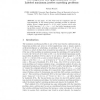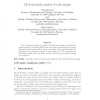2310 search results - page 78 / 462 » Coloring Random Graphs |
JGT
2008
13 years 10 months ago
2008
: This article proves the following result: Let G and G be graphs of orders n and n , respectively. Let G be obtained from G by adding to each vertex a set of n degree 1 neighbors....
TIT
2010
13 years 4 months ago
2010
Motivated by applications to sensor networks and privacy preserving databases, we consider the problem of functional compression. The objective is to separately compress possibly c...
DM
2008
13 years 10 months ago
2008
For graphs G and H, let G H denote their Cartesian sum. This paper investigates the chromatic number and the circular chromatic number for GH. It is proved that (G H) max{ c(G)...
ISAAC
2005
Springer
14 years 3 months ago
2005
Springer
In this paper, we deal with both the complexity and the approximability of the labeled perfect matching problem in bipartite graphs. Given a simple graph G = (V, E) with n vertices...
GC
2010
Springer
13 years 8 months ago
2010
Springer
The b-chromatic number of a graph G is the largest integer k such that G admits a proper k-coloring in which every color class contains at least one vertex adjacent to some vertex...


